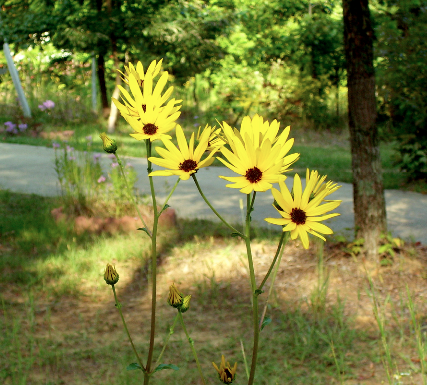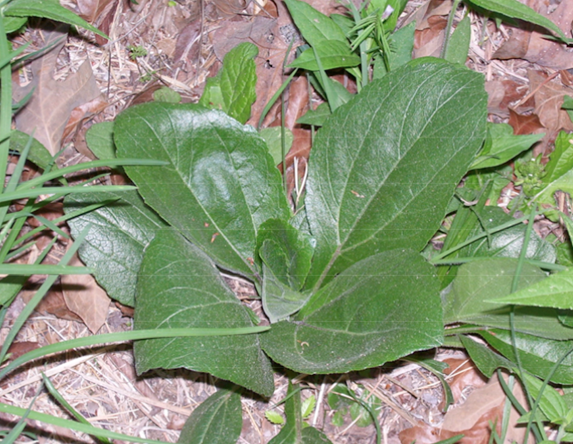Difference between revisions of "Helianthus silphioides"
(→Ecology) |
|||
| Line 39: | Line 39: | ||
===Fire ecology=== <!--Fire tolerance, fire dependence, adaptive fire responses--> | ===Fire ecology=== <!--Fire tolerance, fire dependence, adaptive fire responses--> | ||
Responds favorably to overstory thinning and fire in oak-hickory woodlands in north Mississippi ([[JSB|Steve_Brewer]]). | Responds favorably to overstory thinning and fire in oak-hickory woodlands in north Mississippi ([[JSB|Steve_Brewer]]). | ||
| − | <!--===Pollination | + | <!--===Pollination and use by animals===--> |
| − | |||
<!--===Diseases and parasites===--> | <!--===Diseases and parasites===--> | ||
Revision as of 13:04, 23 June 2021
| Helianthus silphioides | |
|---|---|

| |
| Photo of Helianthus silphioides taken by Steve Brewer | |
| Scientific classification | |
| Kingdom: | Plantae |
| Division: | Magnoliophyta - Flowering plants |
| Class: | Magnoliopsida - Dicotyledons |
| Order: | Asterales |
| Family: | Asteraceae |
| Genus: | Helianthus |
| Species: | H. silphioides |
| Binomial name | |
| Helianthus silphioides Nutt. | |

| |
| Natural range of Helianthus silphioides from USDA NRCS Plant Database | |
Common name: Rosinweed sunflower
Contents
Taxonomic notes
Synonyms: Helianthus atrorubens Linnaeus var. pubescens Kuntze.[1]
Varieties: none.[1]
Description
Clonal perennial
Distribution
This plant's range extends from southern Kentucky, Illinois, and Missouri to Alabama, Mississippi, Louisiana, and eastern Oklahoma.[1]
Ecology
Habitat
H. silphioides has been found in oak/hickory woods, flatwoods, pine forests, stream banks, creek bottoms, prairies, low ridges above rivers, and upland open woods.[2][3][4][5][6] It is also found in disturbed areas including along roadsides and clear-cut flatwoods.[2][6]
Fire ecology
Responds favorably to overstory thinning and fire in oak-hickory woodlands in north Mississippi (Steve_Brewer).
Conservation, cultivation, and restoration
Cultural use
Photo Gallery
References and notes
- ↑ 1.0 1.1 1.2 Weakley, A.S. 2015. Flora of the southern and mid-atlantic states. Working Draft of 21 May 2015. University of North Carolina at Chapel Hill, Chapel Hill, North Carolina.
- ↑ 2.0 2.1 Arkansas Natural Heritage Commission Herbarium accessed using Southeastern Regional Network of Expertise and Collections (ANHC) data portal. URL: http://sernecportal.org/portal/collections/index.php Last accessed: May 2021. Collectors: Sarah Nunn. States and Counties: Arkansas: Clay.
- ↑ Arkansas Tech University Herbarium accessed using Southeastern Regional Network of Expertise and Collections (SERNEC) data portal. URL: http://sernecportal.org/portal/collections/index.php Last accessed: May 2021. Collectors: Quentin Pye. States and Counties: Arkansas: Pope.
- ↑ Illinois Natural History Survey accessed using Southeastern Regional Network of Expertise and Collections (SERNEC) data portal. URL: http://sernecportal.org/portal/collections/index.php Last accessed: May 2021. Collectors: John Schwegman. States and Counties: Missouri: Bollinger.
- ↑ Indiana University Herbarium accessed using Southeastern Regional Network of Expertise and Collections (SERNEC) data portal. URL: http://sernecportal.org/portal/collections/index.php Last accessed: May 2021. Collectors: Delzie Demaree. States and Counties: Arkansas: Clark, Lonoke, and Johnson.
- ↑ 6.0 6.1 Mississippi Museum of Natural Science Herbarium accessed using Southeastern Regional Network of Expertise and Collections (SERNEC) data portal. URL: http://sernecportal.org/portal/collections/index.php Last accessed: May 2021. Collectors: Michael B. Brooks and Jerry A. Clonts. States and Counties: Mississippi: Oktibbeha.
